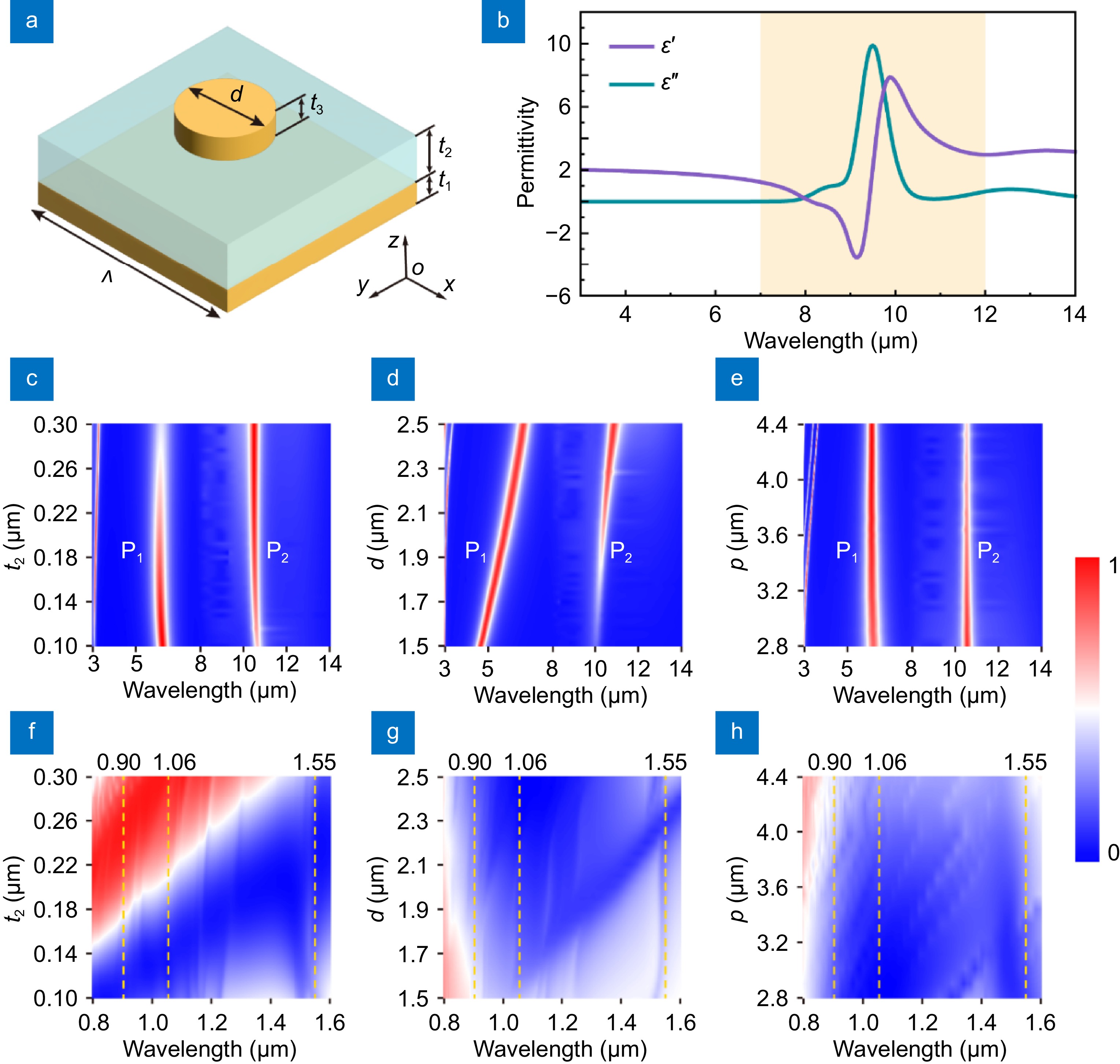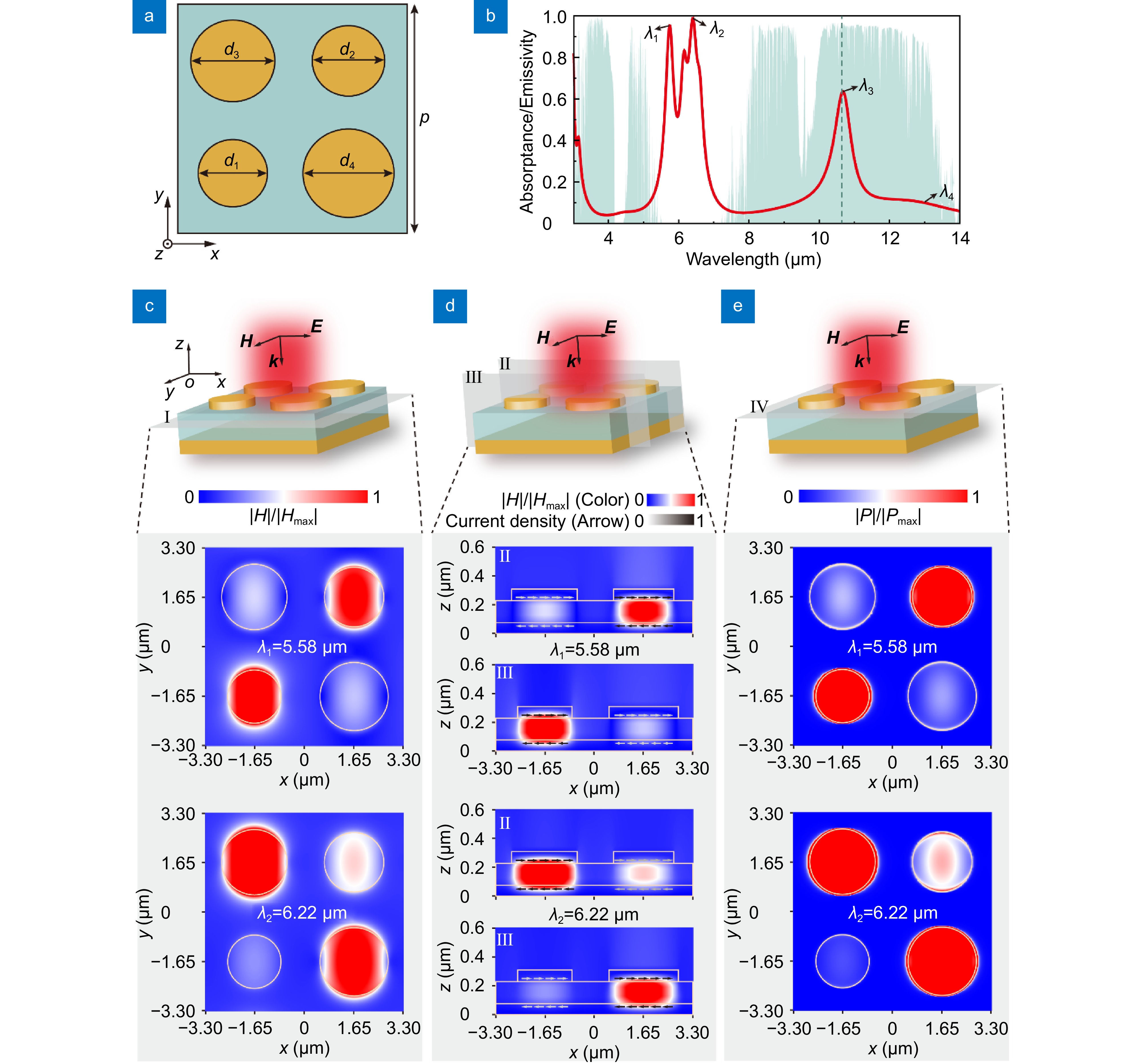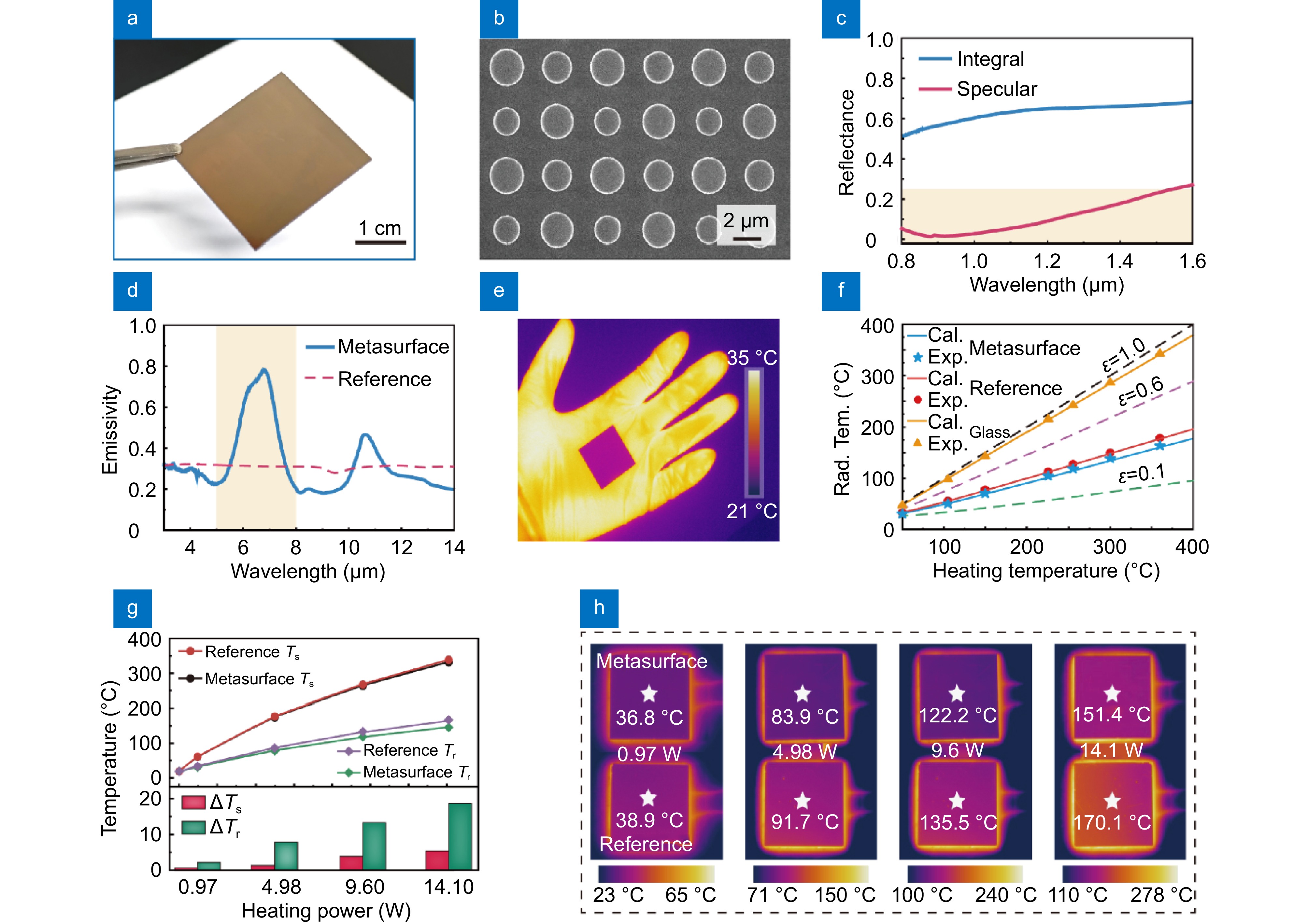| Citation: | Feng XD, Zhang TQ, Liu XJ et al. Single-layer, cascaded and broadband-heat-dissipation metasurface for multi-wavelength lasers and infrared camouflage. Opto-Electron Adv 8, 240280 (2025). doi: 10.29026/oea.2025.240280 |
Single-layer, cascaded and broadband-heat-dissipation metasurface for multi-wavelength lasers and infrared camouflage
-
Abstract
The combination of advanced photoelectric detectors has rendered single-band camouflage materials ineffective, necessitating the development of infrared multispectral camouflage. However, the design and fabrication of existing works remain complex as they usually require the integration of multiscale structures. Here, we introduce phase modulation into the infrared camouflage metasurfaces with metal-dielectric-metal configuration, enabling them to achieve camouflage across more bands. Based on this strategy, a simple but effective single-layer cascaded metasurface is demonstrated for the first time to achieve low reflection at multi-wavelength lasers, low infrared radiation in atmospheric windows, and broadband thermal management. As a proof-of-concept, a 4-inch sample with a minimum linewidth of 1.8 μm is fabricated using photolithography. The excellent infrared multispectral camouflage performance is verified in experiments, showing low reflectance in 0.9–1.6 μm, low infrared emissivity in mid-wavelength infrared (MWIR) and long-wavelength infrared (LWIR) bands, and high absorptance at the wavelength of 10.6 μm. Meanwhile, broadband high emissivity in 5–8 μm can provide high-performance radiative heat dissipation. When the input power is 1.57 W∙cm-2, the surface/radiation temperature of the metasurface decreases by 5.3 °C/18.7 °C compared to the reference. The proposed metasurface may trigger further innovation in the design and application of compact multispectral optical devices. -

-
References
[1] Ermatov T, Noskov RE, Machnev AA et al. Multispectral sensing of biological liquids with hollow-core microstructured optical fibres. Light Sci Appl 9, 173 (2020). doi: 10.1038/s41377-020-00410-8 [2] Wu RH, Sui CX, Chen TH et al. Spectrally engineered textile for radiative cooling against urban heat islands. Science 384, 1203–1212 (2024). doi: 10.1126/science.adl0653 [3] Mu G, Tan YM, Bi C et al. Visible to mid-wave infrared PbS/HgTe colloidal quantum dot imagers. Nat Photonics 18, 1147–1154 (2024). doi: 10.1038/s41566-024-01492-1 [4] Zhu HZ, Li Q, Tao CN et al. Multispectral camouflage for infrared, visible, lasers and microwave with radiative cooling. Nat Commun 12, 1805 (2021). doi: 10.1038/s41467-021-22051-0 [5] Xie X, Li X, Pu MB et al. Plasmonic metasurfaces for simultaneous thermal infrared invisibility and holographic illusion. Adv Funct Mater 28, 1706673 (2018). doi: 10.1002/adfm.201706673 [6] Feng XD, Pu MB, Zhang F et al. Large-area low-cost multiscale-hierarchical metasurfaces for multispectral compatible camouflage of dual-band lasers, infrared and microwave. Adv Funct Mater 32, 2205547 (2022). doi: 10.1002/adfm.202205547 [7] Wu Y, Tan SJ, Zhao Y et al. Broadband multispectral compatible absorbers for radar, infrared and visible stealth application. Prog Mater Sci 135, 101088 (2023). doi: 10.1016/j.pmatsci.2023.101088 [8] Lu XW, Sun L, Jiang P et al. Progress of photodetectors based on the photothermoelectric effect. Adv Mater 31, 1902044 (2019). doi: 10.1002/adma.201902044 [9] Teng F, Hu K, Ouyang WX et al. Photoelectric detectors based on inorganic p-type semiconductor materials. Adv Mater 30, 1706262 (2018). doi: 10.1002/adma.201706262 [10] Molebny V, McManamon PF, Steinvall O et al. Laser radar: historical prospective—from the East to the West. Opt Eng 56, 031220 (2016). doi: 10.1117/1.OE.56.3.031220 [11] Feng XD, Xie X, Pu MB et al. Hierarchical metamaterials for laser-infrared-microwave compatible camouflage. Opt Express 28, 9445–9453 (2020). doi: 10.1364/OE.388335 [12] Yu K, Zhang W, Qian MD et al. Multiband metamaterial emitters for infrared and laser compatible stealth with thermal management based on dissipative dielectrics. Photonics Res 11, 290–298 (2023). doi: 10.1364/PRJ.476109 [13] Liu XH, Wang P, Xiao CY et al. A bioinspired bilevel metamaterial for multispectral manipulation toward visible, multi‐wavelength detection lasers and mid‐infrared selective radiation. Adv Mater 35, 2302844 (2023). doi: 10.1002/adma.202302844 [14] Dang SC, Ye H. A visible-infrared-compatible camouflage photonic crystal with heat dissipation by radiation in 5–8 μm. Cell Rep Phys Sci 2, 100617 (2021). doi: 10.1016/j.xcrp.2021.100617 [15] Jiang XP, Yuan H, He X et al. Implementing of infrared camouflage with thermal management based on inverse design and hierarchical metamaterial. Nanophotonics 12, 1891–1902 (2023). doi: 10.1515/nanoph-2023-0067 [16] Qin B, Zhu YN, Zhou YW et al. Whole-infrared-band camouflage with dual-band radiative heat dissipation. Light Sci Appl 12, 246 (2023). doi: 10.1038/s41377-023-01287-z [17] Hu R, Xi W, Liu YD et al. Thermal camouflaging metamaterials. Mater Today 45, 120–141 (2021). doi: 10.1016/j.mattod.2020.11.013 [18] Pan MY, Huang Y, Li Q et al. Multi-band middle-infrared-compatible camouflage with thermal management via simple photonic structures. Nano Energy 69, 104449 (2020). doi: 10.1016/j.nanoen.2020.104449 [19] Kim T, Bae JY, Lee N et al. Hierarchical metamaterials for multispectral camouflage of infrared and microwaves. Adv Funct Mater 29, 1807319 (2019). doi: 10.1002/adfm.201807319 [20] Greffet JJ, Nieto-Vesperinas M. Field theory for generalized bidirectional reflectivity: derivation of Helmholtz’s reciprocity principle and Kirchhoff’s law. J Opt Soc Am A 15, 2735–2744 (1998). doi: 10.1364/JOSAA.15.002735 [21] Yu NF, Genevet P, Kats MA et al. Light propagation with phase discontinuities: generalized laws of reflection and refraction. Science 334, 333–337 (2011). doi: 10.1126/science.1210713 [22] Pu MB, Li X, Ma XL et al. Catenary optics for achromatic generation of perfect optical angular momentum. Sci Adv 1, e1500396 (2015). doi: 10.1126/sciadv.1500396 [23] Song QH, Odeh M, Zúñiga-Pérez J et al. Plasmonic topological metasurface by encircling an exceptional point. Science 373, 1133–1137 (2021). doi: 10.1126/science.abj3179 [24] Chen WT, Zhu AY, Sanjeev V et al. A broadband achromatic metalens for focusing and imaging in the visible. Nat Nanotechnol 13, 220–226 (2018). doi: 10.1038/s41565-017-0034-6 [25] Wang YL, Fan QB, Xu T. Design of high efficiency achromatic metalens with large operation bandwidth using bilayer architecture. Opto-Electron Adv 4, 200008 (2021). doi: 10.29026/oea.2021.200008 [26] Li XY, Chen C, Guo YH et al. Monolithic spiral metalens for ultrahigh‐capacity and single‐shot sorting of full angular momentum state. Adv Funct Mater 34, 2311286 (2024). doi: 10.1002/adfm.202311286 [27] Li X, Chen LW, Li Y et al. Multicolor 3D meta-holography by broadband plasmonic modulation. Sci Adv 2, e1601102 (2016). doi: 10.1126/sciadv.1601102 [28] Gopakumar M, Lee GY, Choi S et al. Full-colour 3D holographic augmented-reality displays with metasurface waveguides. Nature 629, 791–797 (2024). doi: 10.1038/s41586-024-07386-0 [29] Wu H, Huang YA, Xu F et al. Energy harvesters for wearable and stretchable electronics: from flexibility to stretchability. Adv Mater 28, 9881–9919 (2016). doi: 10.1002/adma.201602251 [30] Jiang S, Guo DL, Zhang L et al. Electropolishing-enhanced, high-precision 3D printing of metallic pentamode metamaterials. Mater Des 223, 111211 (2022). doi: 10.1016/j.matdes.2022.111211 [31] Wang YL, Zhao C, Wang JJ et al. Wearable plasmonic-metasurface sensor for noninvasive and universal molecular fingerprint detection on biointerfaces. Sci Adv 7, eabe4553 (2021). doi: 10.1126/sciadv.abe4553 [32] Xiong YX, Lin ZQ, Zhao ZY et al. A template-stripped carbon nanofiber/poly(styrene-butadiene-styrene) compound for high-sensitivity pressure and strain sensing. Soft Sci 2, 14 (2022). doi: 10.20517/ss.2022.12 [33] Zhou YL, Wang SL, Yin JY et al. Flexible metasurfaces for multifunctional interfaces. ACS Nano 18, 2685–2707 (2024). doi: 10.1021/acsnano.3c09310 [34] Arab Hassani F. Bioreceptor-inspired soft sensor arrays: recent progress towards advancing digital healthcare. Soft Sci 3, 31 (2023). [35] Xie F, Jin WL, Nolen JR et al. Subambient daytime radiative cooling of vertical surfaces. Science 386, 788–794 (2024). doi: 10.1126/science.adn2524 [36] Lee N, Lim JS, Chang I et al. Flexible thermocamouflage materials in supersonic flowfields with selective energy dissipation. ACS Appl Mater Interfaces 13, 43524–43532 (2021). doi: 10.1021/acsami.1c09333 [37] Lee N, Kim T, Lim JS et al. Metamaterial-selective emitter for maximizing infrared camouflage performance with energy dissipation. ACS Appl Mater Interfaces 11, 21250–21257 (2019). doi: 10.1021/acsami.9b04478 [38] Lee N, Yoon B, Kim T et al. Multiple resonance metamaterial emitter for deception of infrared emission with enhanced energy dissipation. ACS Appl Mater Interfaces 12, 8862–8869 (2020). doi: 10.1021/acsami.9b21030 [39] Wu YJ, Luo J, Pu MB et al. Optically transparent infrared selective emitter for visible-infrared compatible camouflage. Opt Express 30, 17259–17269 (2022). doi: 10.1364/OE.457547 [40] Guo HT, Yang XL, Zhu D. Easy-to-manufacture in-line 2D nano antenna for enhanced radiation-cooled IR camouflage. ACS Photonics 10, 1405–1415 (2023). doi: 10.1021/acsphotonics.3c00024 [41] Li W, Wu SL, Tian CH et al. Multi-resonance coupled metal pattern metamaterial for selective thermal emission. J Nanophoton 18, 016012 (2024). [42] Lim JS, Lee N, Kim T et al. Multiresonant selective emitter with enhanced thermal management for infrared camouflage. ACS Appl Mater Interfaces 16, 15416–15425 (2024). doi: 10.1021/acsami.3c15504 [43] Zhang CL, Huang C, Pu MB et al. Dual-band wide-angle metamaterial perfect absorber based on the combination of localized surface plasmon resonance and Helmholtz resonance. Sci Rep 7, 5652 (2017). doi: 10.1038/s41598-017-06087-1 [44] Pu MB, Zhao ZY, Wang YQ et al. Spatially and spectrally engineered spin-orbit interaction for achromatic virtual shaping. Sci Rep 5, 9822 (2015). doi: 10.1038/srep09822 [45] Xi W, Lee YJ, Yu SL et al. Ultrahigh-efficient material informatics inverse design of thermal metamaterials for visible-infrared-compatible camouflage. Nat Commun 14, 4694 (2023). doi: 10.1038/s41467-023-40350-6 [46] Wei H, Gu JX, Zhao T et al. Tunable VO2 cavity enables multispectral manipulation from visible to microwave frequencies. Light Sci Appl 13, 54 (2024). doi: 10.1038/s41377-024-01400-w [47] Huang JK, Wang YT, Yuan LM et al. Large‐area and flexible plasmonic metasurface for laser–infrared compatible camouflage. Laser Photonics Rev 17, 2200616 (2023). doi: 10.1002/lpor.202200616 [48] Koechlin C, Bouchon P, Pardo F et al. Total routing and absorption of photons in dual color plasmonic antennas. Appl Phys Lett 99, 241104 (2011). doi: 10.1063/1.3670051 [49] Bouchon P, Koechlin C, Pardo F et al. Wideband omnidirectional infrared absorber with a patchwork of plasmonic nanoantennas. Opt Lett 37, 1038–1040 (2012). doi: 10.1364/OL.37.001038 [50] Chen YB, Chiu FC. Trapping mid-infrared rays in a lossy film with the Berreman mode, epsilon near zero mode, and magnetic polaritons. Opt Express 21, 20771–20785 (2013). doi: 10.1364/OE.21.020771 [51] Hao JM, Wang J, Liu XL et al. High performance optical absorber based on a plasmonic metamaterial. Appl Phys Lett 96, 251104 (2010). doi: 10.1063/1.3442904 -
Supplementary Information
Supplementary information for Single-layer, cascaded and broadband-heatdissipation metasurface for multi-wavelength lasers and infrared camouflage 
-
Access History

Article Metrics
-
Figure 1.
Camouflage principles illustration and schematic of the proposed metasurface. (a) Concept illustration of the camouflage principles in different bands. When the multispectral waves incident on the cascaded metasurface, the light in the NIR band (i.e., 0.8–1.6 μm) will be guided to four non-specular angles; the waves in infrared atmospheric windows (i.e., 3–5 μm and 8–14 μm) will be reflected (corresponding to low emissivity in these bands); the light at 10.6 μm will be absorbed; and the high emissivity in 5–8 μm will lead to a broadband heat dissipation. (b) The atmospheric transmittance spectra in the NIR, MWIR, and LWIR bands, as well as the ideal reflectance spectra for infrared multispectral camouflage. (c) The SEM image of the fabricated metasurface. (d) Thermal infrared image of the metasurface held by the researcher at room temperature.
-
Figure 2.
Amplitude and phase modulation characteristics of the metasurface with single-sized metallic disks. (a) Schematic of the unit cell. (b) The permittivity of SiO2 in 3–14 μm, containing the real and imaginary parts of ε' and ε''. Dependence of the absorption spectra in 3–14 μm and reflection spectra in 0.8–1.6 μm on different geometric structures: (c, f) the dielectric layer thickness from 0.1 to 0.3 μm with Λ = 3.3 μm and d = 2.2 μm; (d, g) the diameter of the top Au disks from 1.5 to 2.5 μm with Λ = 3.3 μm and t2 = 0.14 μm; (e, h) the period from 2.8 to 4.4 μm with t2 = 0.14 μm and d = 2.2 μm.
-
Figure 3.
Amplitude modulation characteristics of the cascaded metasurface. (a) Top view of the proposed metasurface cascading four metallic disks. (b) Absorptance (emissivity) spectra of the cascaded metasurface in the band of 3–14 μm. λ1 and λ2 indicate the resonant wavelengths in 5–8 μm, λ3 corresponds to the wavelength of 10.6 μm, and λ4 is a non-resonant wavelength. (c) Magnetic field intensity on the z = 0.2 μm plane (cross-section I) at the resonance wavelengths of 5.58 μm and 6.22 μm. (d) Magnetic field intensity and current density on the y = ±1.65 μm planes (cross-sections II and III) at the resonance wavelengths of 5.58 μm and 6.22 μm. (e) Power loss intensity on the z = 0.23 μm plane (cross-section IV) at the resonance wavelengths of 5.58 μm and 6.22 μm.
-
Figure 4.
Phase modulation characteristics of the cascaded metasurface in the NIR band. (a) Cross-sectional view of the metasurface in the y = 1.65 μm plane. It also depicts the different transmission paths and their reflection phases, as well as the incident wave and its scattering field. (b) Reflection phases of Ф1 and Ф2, and the relative phase difference between them (ΔФ). (c) The electric field distribution on the x = −1.65 μm plane at 1.06 μm. (d) Specular (zero-order) reflection spectra of the metasurface and a gold plate under normal incidence in 0.8–1.6 μm. (e) The 3D far-field scattering pattern of the metasurface at 1.06 μm. (f) The normalized scattering patterns of the metasurface and a gold plate on φ = 0° (or 90°) plane at 1.06 μm.
-
Figure 5.
Fabrication and characterization results of the metasurface. (a, b) show the photograph and SEM images of the prepared metasurface sample, respectively. (c) Measured specular and integral reflectance spectra of the metasurface in 0.8–1.6 μm. (d) The measured emissivity of the metasurface and reference in 3–14 μm. (e) Thermal infrared image of the fabricated sample held by the researcher at room temperature. (f) The radiative temperatures of the metasurface, reference, and glass at different heating temperatures in the LWIR band. The solid lines represent the radiative temperatures calculated based on the average emissivity within this range, the different symbols (including stars, circles, and triangles) represent the radiative temperatures obtained from the infrared camera, and the dashed lines correspond to the radiative temperatures associated with different emissivities. (g) The surface and radiation temperatures at various input powers, and their differences between the metasurface and the reference. (h) Thermal infrared images of the metasurface and reference at different input powers.

 E-mail Alert
E-mail Alert RSS
RSS
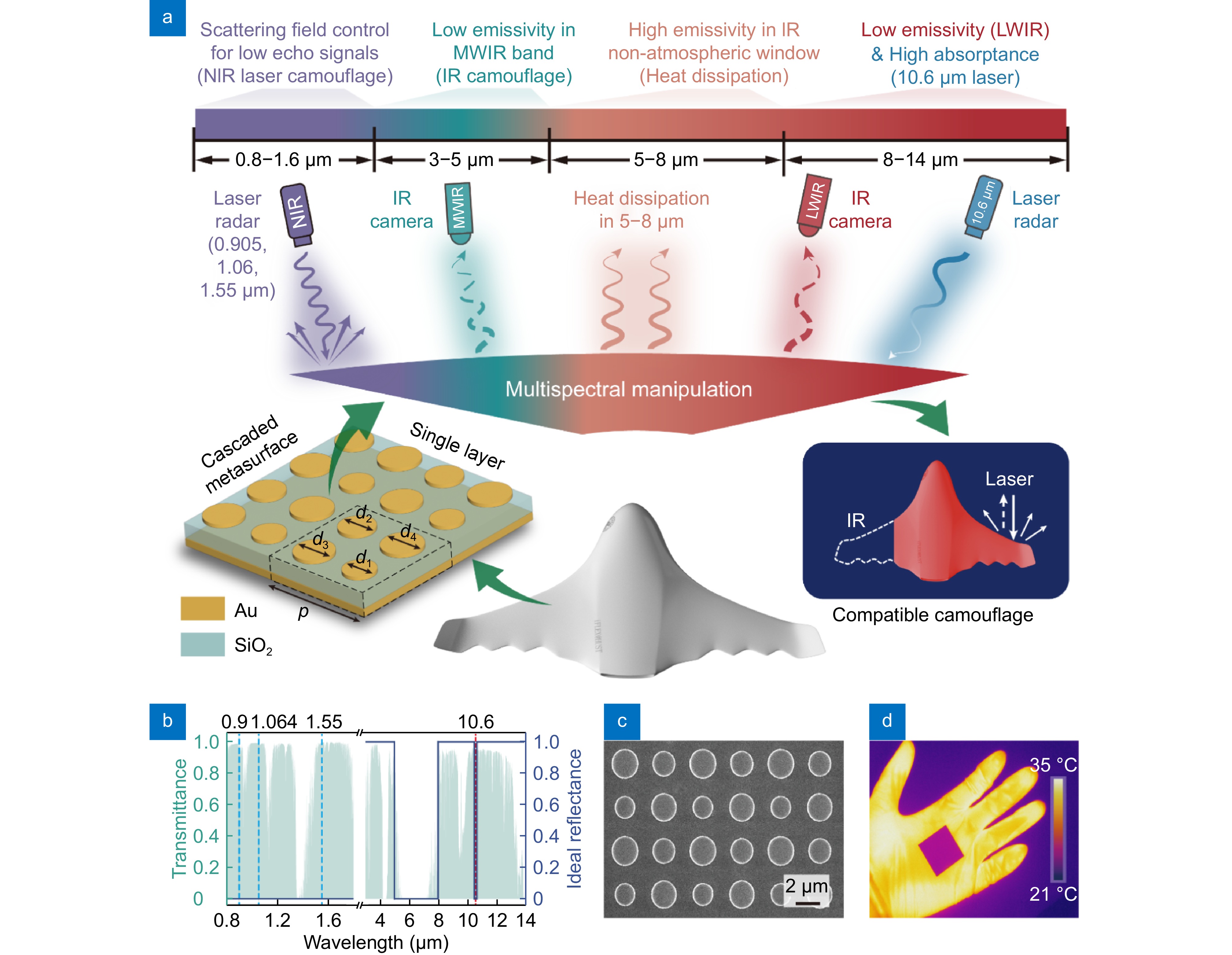

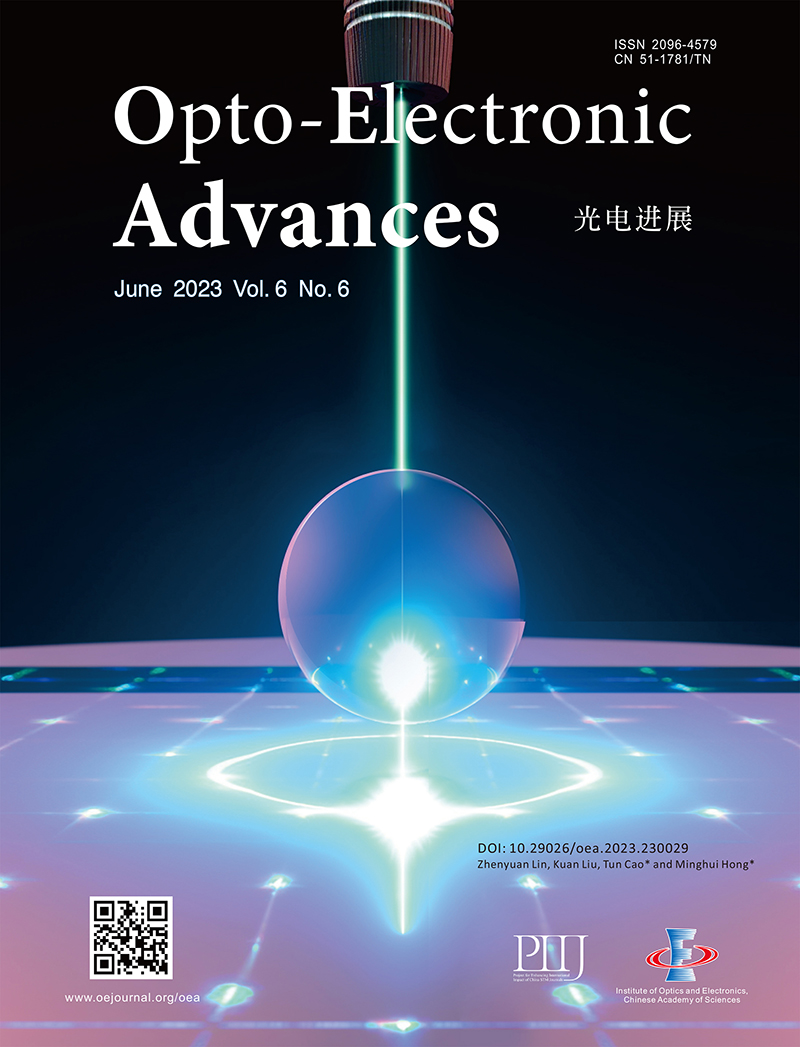
 DownLoad:
DownLoad:
